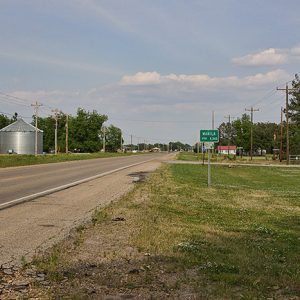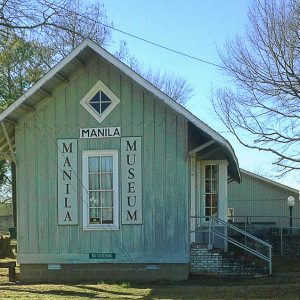calsfoundation@cals.org
Manila (Mississippi County)
| Latitude and Longitude: | 35°52’48″N 090°10’01″W |
| Elevation: | 243 feet |
| Area: | 3.76 square miles (2020 Census) |
| Population: | 3,682 (2020 Census) |
| Incorporation Date: | July 3, 1901 |
Historical Population as per the U.S. Census:
|
1810 |
1820 |
1830 |
1840 |
1850 |
1860 |
1870 |
1880 |
1890 |
1900 |
|
– |
– |
– |
– |
– |
– |
– |
– |
– |
– |
|
1910 |
1920 |
1930 |
1940 |
1950 |
1960 |
1970 |
1980 |
1990 |
2000 |
|
562 |
971 |
1,226 |
1,248 |
1,729 |
1,753 |
1,961 |
2,553 |
2,635 |
3,055 |
|
2010 |
2020 |
|
|
|
|
|
|
|
|
|
3,342 |
3,682 |
|
|
|
|
|
|
|
In many ways, Manila is like other small towns of the northeastern Arkansas Delta. During the 1950s, such towns were vital to the development of the area and provided essential goods and services to farmers and their families, but the mechanization of agriculture led people to migrate to urban areas. In that respect, Manila has not experienced the population decrease of its Mississippi County contemporaries, primarily because “white flight” from the nearby towns of Blytheville and Osceola has led people to relocate to Manila.
John U. Needham came to the Manila area in 1868 to establish a permanent camp for his grazing stock. He selected the highest, driest spot of the land that was once a part of the “Great Swamp.” Manila is located in the center of an agricultural district with some of the richest farmland in the state around the borders of Big Lake Island, which was formed during the New Madrid Earthquake in 1812. The town is situated on Buffalo Island, which is conjointly composed of land in Mississippi County’s western portion and land in Craighead County; it is an island only in the metaphorical sense, as Little River and Big Lake divide this area from the remainder of Mississippi County.
In 1900, twenty registered voters of what was then the little community of Cinda (named after Lucinda, the postmaster’s sister) were selected to represent the town’s bid for incorporation. They decided to incorporate on July 3, 1901, under the name Manila to honor Commodore George Dewey’s accomplishments during the Spanish-American War; Dewey’s decisive battle at Manila Bay was the beginning of the war between Spain and the United States and led to American control of the Philippines for some time.
By 1900, the extensive timber in the area attracted the attention of the railroads. Railroad companies recognized that substantial profits could be made from shipments of the boundless timber from the area to sawmills for processing and shipping the prepared timber to northern markets. The town grew rapidly when the Jonesboro, Lake City and Eastern (JLC&E) extended its line to Manila on December 2, 1900. The JLC&E operated four trains daily until 1938, when it sold to the Saint Louis and San Francisco Railroad Company. Passenger and mail service was discontinued on May 15, 1948. From that point, the railroad was used exclusively for freight shipments. Built in 1910, the Manila Depot officially closed on December 30, 1977, but twenty years later, it was restored to its original condition and turned into a museum; it was placed on the National Historic Register on March 8, 1997.
Living in close proximity of the Mississippi River was both a blessing and a curse for the people of Manila. Thousands of years of flooding made the rich alluvial soil excellent for growing crops; however, the threat of floods created havoc in the lives of the people. The first levee around Manila was built by 1920. The levees broke in the devastating 1927 flood and again in the 1937 flood. Through the efforts of local landowners, the United States Army Corps of Engineers built the present levees around Big Lake in 1938.
Since its earliest days, the area was known for its abundance of wild game and fish. Big Lake, which is four miles from Manila, became a popular hub for hunters and fishermen from Arkansas and surrounding states. This early industry used the railroad to ship huge quantities of fur, fish, and game to markets outside the state. The wild duck market on Big Lake began around 1890 and lasted until President Woodrow Wilson named it a Federal Game Reserve in 1915, having been persuaded to do so by people such as plantation owner Robert E. Lee Wilson and others who had hunting clubs on Big Lake and worked to exclude independent market hunters from the area.
In the late 1880s, Manila’s first school was located about one-half mile north of its present location on Olympia and Davis streets. Teacher Benjamin Bollinger taught students in a one-room schoolhouse. Most students only completed a few grades at the little elementary school. However, on May 21, 1926, Manila graduated its first class of five seniors. Manila also has the distinction of forming the first Boy Scout troop in Arkansas in 1911.
Manila was home to Herman Davis, a soldier who General John Pershing called “America’s fourth greatest hero” of World War I. Davis won the Distinguished Service Cross, the French Croix de Guerre with Palm, and the French Medaille Militaire. A monument, carved in Italy, consisting of a marble obelisk behind a life-size statue of Davis, was dedicated on Memorial Day in 1925. The monument, along with its surrounding grounds, has the distinction of being the smallest state park in Arkansas.
The Depression affected Manila in the same way it did other small towns in the Delta, with foreclosures and sharecropping families leaving crops in the field because it was cheaper than trying to harvest them. Many sharecroppers left in the middle of the night to avoid the landlords, to whom they were in extreme debt. With the advent of World War II, many young men and women signed up and never returned to the farm. Some residents of Manila left town to work in factories elsewhere in the state or in the North.
One Manila resident did have an effect larger than the town from which he came. E. C. Fleeman was elected to the Arkansas state legislature in 1944 and served nine terms, becoming in 1959 the first speaker of the house from Mississippi County. He was one of the legislative leaders instrumental in the fight to secure university status for what was then Arkansas State College, now Arkansas State University.
For the longest time, Manila was a “sundown town,” a place where it was not safe for an African American to be after dark. Only recently has Manila had any black residents or business owners, though many African Americans from Osceola and Blytheville have long patronized the services the town offers.
The few cotton gins that used to be in Manila have all gone to nearby locations and become co-ops. Many of the small farmers in the area have recently been bought out by larger enterprises and now work for corporations rather than themselves. However, a hydraulic lift manufacturer, a federal warehouse, two computer stores, and the run of restaurants, discount stores, and doctors’ offices offer a range of employment for the residents of the town.
The Manila Depot Committee oversees two museums on Baltimore Avenue: the Manila Depot Museum and the Main Street Historical Museum.
For additional information:
Bicentennial edition. Northeast Arkansas Town Crier. June 17, 1976.
Jackson, Donna. “Manila: 1901–2001, A Centennial Celebration.” Jonesboro, AR: Master Printing Company, 2001.
“Manila Hunting Fishing Paradise.” Manila Sentinel. March 7, 1952, p. 6A.
Donna Brewer Jackson
Manila, Arkansas
 Herman Davis Funeral
Herman Davis Funeral  Herman Davis Monument
Herman Davis Monument  Manila
Manila  Manila Service Station
Manila Service Station  Manila Depot Museum and Main Street Historical Museum
Manila Depot Museum and Main Street Historical Museum  Manila Derailment
Manila Derailment  Manila Hotel and Grocery
Manila Hotel and Grocery  Manila Stave Mill
Manila Stave Mill  Manila Street Scene
Manila Street Scene  Manila Street Scene
Manila Street Scene  Mississippi County Map
Mississippi County Map 




Comments
No comments on this entry yet.